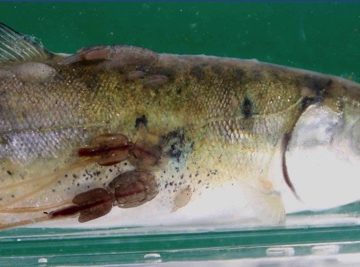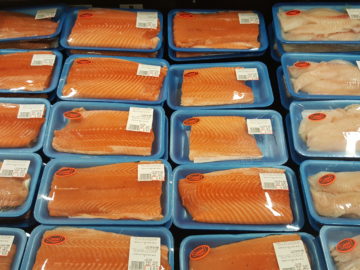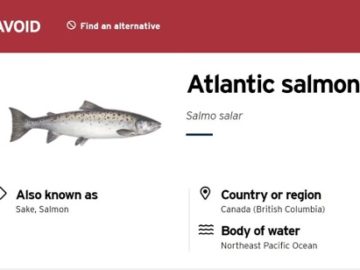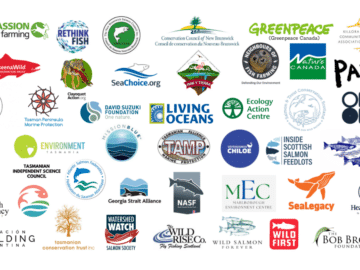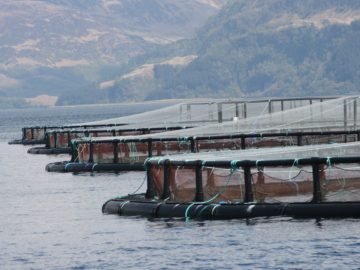Halifax/Kjipuktuk AND Vancouver/traditional unceded territories of the xwməθkwəy̓əm (Musqueam), Sḵwx̱wú7mesh (Squamish) and səlilwətaɬ (Tsleil-waututh) First Nations — The salmon farming industry’s go to eco-certifier, the Aquaculture Stewardship Council, continues to weaken its standard for certified farms. It is now prioritizing business-as-usual practices over protecting vulnerable wild salmon and sea trout from farm-derived sea lice.
The ASC’s new Salmon Standard (v1.4) dramatically increases — up to 1,550 per cent in some regions — the number of sea lice allowed on certified farms. The revised standard removes the precautionary maximum sea lice limit, which was established through technical expertise and multi-stakeholder dialogues and was meant to hold farms to a higher standard than what is merely legally required of them.
Instead of a scientific robust lice limit for farms seeking the ASC label to earn a premium price in the marketplace, the ASC is allowing fish to be certified as “responsibly farmed” as long as they meet status quo sea lice limits set by governments. Such lice limits have failed to protect out-migrating juvenile wild salmon from farm-generated sea lice.
“Over the past decade, sea lice outbreaks on farms have worsened and drug resistance has accelerated, while regulations and enforcement are either insufficient or non-existent,” said Kilian Stehfest, SeaChoice representative from David Suzuki Foundation. “This should be reason enough to tighten sea lice requirements. Instead, the certification scheme’s decision to default to local laws means it no longer pushes industry to do better. It supports the status quo and the serious risk to wild fish populations that represents.”
The revision includes a new 21-day deadline for farms to bring lice levels down below the limit or face not being able to use the ASC label. “While we hope this means we will no longer see ASC-certified farms with sea lice levels as high as 31 lice per fish sold into the marketplace, nothing prevents a farm during that three-week period from harvesting and selling their fish with the ‘farmed responsibly’ label,” said Kelly Roebuck, SeaChoice representative from Living Oceans Society.
During the consultation phase of the sea lice revision, multiple conservation groups argued that the ASC must go beyond mere government regulations to remain a credible and meaningful certifier.
“Unfortunately, the ASC did not heed the calls of the conservation community. There is nothing “responsible” about placing juvenile wild salmon at risk,” concluded Roebuck.
Note: The absence of other eco-certifications from this news release should not be taken as an endorsement for those schemes.
For more information, please see the full press release here with backgrounder on pages 3-4.
Media contacts:
Karen Wristen, Executive Director of Living Oceans Society and SeaChoice Steering Committee member: mobile 604-788-5634; email kwristen@livingoceans.org
Kilian Stehfest, Marine Conservation Specialist at David Suzuki Foundation and SeaChoice representative: mobile 778-686-7472; email kstehfest@davidsuzuki.org
About SeaChoice: SeaChoice is a collaboration of three internationally recognized organizations — the David Suzuki Foundation, Ecology Action Centre and Living Oceans Society — that use their broad, national expertise to find solutions for healthy oceans. SeaChoice is a science-based, solutions-focused influencer, advocate and watchdog leading the next evolution of seafood sustainability in Canada.
SeaChoice member groups have been active stakeholders in the ASC and Salmon Aquaculture Dialogue for over 15 years. This included steering committee representation during the original Dialogue, core participation in numerous ASC advisory and working groups, active stakeholder engagement on ASC audits and projects and public watchdogging of the ASC.
About WildFish: WildFish (formerly known as Salmon & Trout Conservation) is a conservation charity working to protect wild fish and their waters. Using science and the law, its dedicated team campaigns to influence government policy, industrial practice and individual behaviour.
Its goal is the measurable improvement of the state of the water environment so we can enjoy healthier wild fish stocks, improved biodiversity and less pollution in our rivers, lakes and oceans.
For more information, please see the full press release here with backgrounder on pages 3-4.
